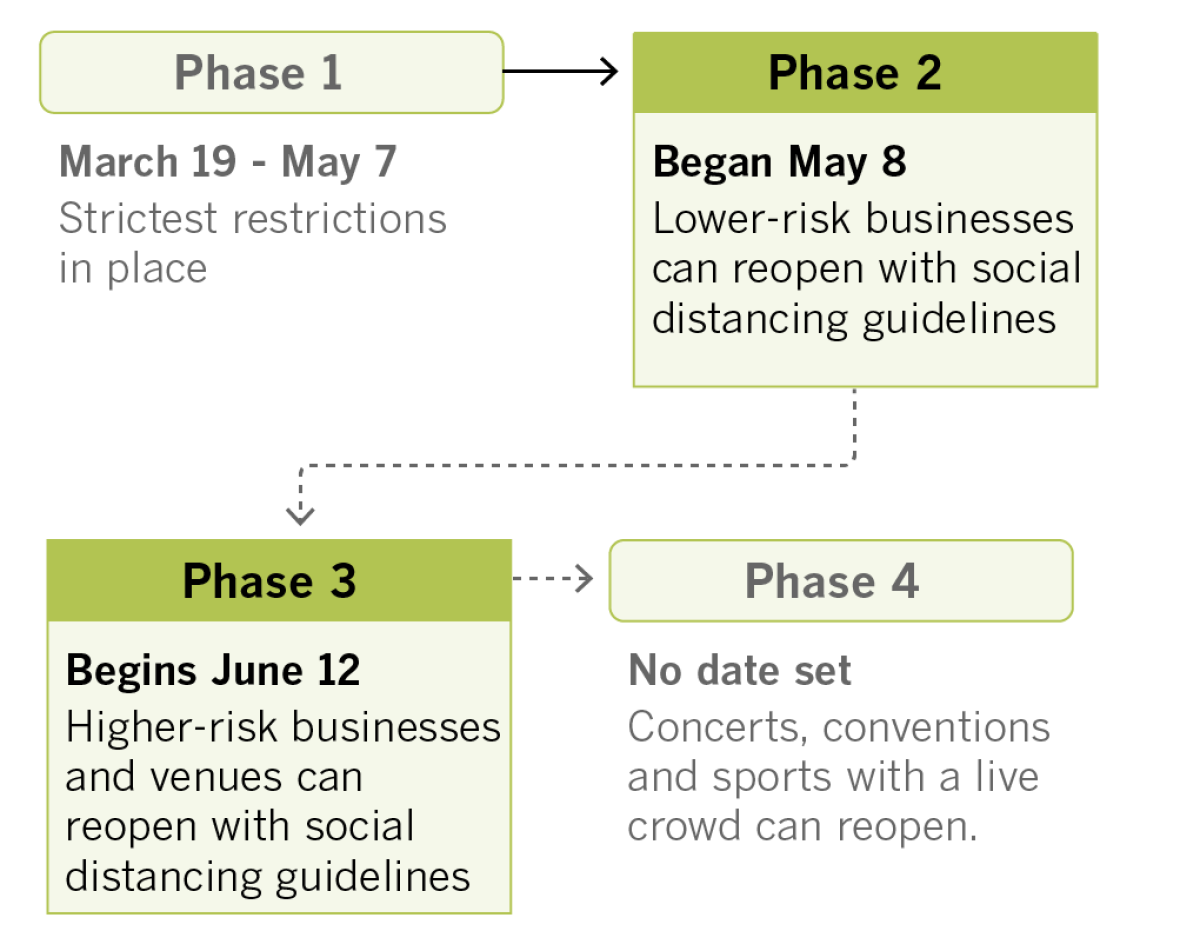Coronavirus Today: ‘The young invincibles’
Good evening. I’m Diya Chacko, and it’s Monday, July 6. Here’s what’s happening with the coronavirus in California and beyond.
This year’s Fourth of July holiday had the dubious distinction of marking the 15th consecutive day of record COVID-19 hospitalization numbers across California. Statewide, the number of intensive care unit patients with confirmed coronavirus infections is up 63% over the last three weeks. And the rate at which coronavirus tests are coming back positive has jumped 39% over the last two weeks, Gov. Gavin Newsom said.
Newsom said Monday that the state will expand monitoring of counties hit hard by the virus after cracking down on restaurants and bars that ignored restrictions over the weekend. On Sunday, two more counties were added to the list of those being monitored for their rising case counts and hospitalizations: Contra Costa and Colusa. That brings the total number of counties under watch to 23. In many areas, the jump in cases is attributed to more people leaving home and a rise in gatherings.
While the rate of deaths has not increased at the same pace as the number of cases and hospitalizations, officials say that’s partly because new cases are now skewing more heavily toward younger people. “A lot of these younger folks may be coming into hospitals, but with not as acute needs as what we were seeing in the past,” Newsom said. He referred to them as “the young invincibles,” and said they “don’t feel it’s going to impact them and if it does, it’s not a big burden.”
But experts have warned that increasing infection rates in younger adults may facilitate the virus’ spread to more vulnerable people, such as those with underlying health conditions and older adults. Officials fear that as cases continue to rise rapidly, the death rate may soon spike once more. “Deaths will often lag behind slightly, as much as one to three weeks,” said Barbara Ferrer, who heads L.A. County’s Public Health Department.
And we won’t know whether gatherings during the Fourth of July weekend contributed to disease transmission “for another 14 days,” Ferrer said. She noted that extensive gatherings over the Memorial Day holiday drove the increase in infections two weeks later.
By the numbers
California cases and deaths as of 5:30 p.m. PDT Monday:

Track the latest numbers and how they break down in California with our graphics.

See which counties are reopening with our tracker.
Consider subscribing to the Los Angeles Times
Your support helps us deliver the news that matters most. Become a subscriber.
Across California
Beaches in Los Angeles and Ventura counties reopened Monday after officials closed them to discourage large gatherings over the holiday weekend. Absent other options, residents traveled to beaches in San Diego County, and to San Clemente Beach, one of the few in Orange County that stayed open.
In Sacramento, the state Capitol closed Monday after Assemblywoman Autumn Burke (D-Marina Del Rey) and four others who work in the building tested positive for the coronavirus. Burke said she was told she was exposed to the virus when the Assembly met to pass the state budget. Lawmakers were scheduled to return from summer recess July 13, but California’s Assembly leader said Monday he will be delaying legislative hearings until further notice.
The federal government has doled out upward of $68 billion to more than 580,000 California businesses and organizations in the last three months as part of the Paycheck Protection Program, according to data released Monday by the Trump administration. Those recipients included Jelly Belly, Kanye West’s Yeezy apparel company and the SETI Institute, a nonprofit dedicated to the search for extraterrestrial life. Within hours of the data’s release, however, some California companies were disputing its accuracy.
Prison authorities on Monday announced the replacement of the state correction system’s top medical officer. The leadership shakeup occurred as corrections officials reported three more deaths at San Quentin State Prison over the Fourth of July weekend, bringing the total to six. More than one-third of inmates at the prison have tested positive for the coronavirus. Statewide, at least 28 inmates have died of coronavirus-related illnesses, and more than 2,400 are currently infected.
The Angels were one of at least four teams that experienced coronavirus testing delays over the first weekend of training camp, prompting players to administer their own tests. Health experts say timely testing is crucial for sports leagues to identify and isolate players who test positive, and to prevent the spread of the virus among players as they resume workouts.
Resources
— For general safety, wash your hands for at least 20 seconds (here’s a super-fun how-to video). Stop touching your face, and keep your phone clean. Practice social distancing, maintaining a six-foot radius of personal space in public. And wear a mask if you leave home. Here’s how to do it right.
— Watch for symptoms including fever, cough, shortness of breath, chills, repeated shaking with chills, muscle pain, headache, sore throat and loss of taste or smell. If you’re worried you might be infected, call your doctor or urgent care clinic before going there.
— Need a COVID-19 test? Here’s how to receive a free test if you’re in L.A. County. And here’s a map of testing sites across California.
— Here’s how to care for someone with COVID-19, from monitoring their symptoms to preventing the virus’ spread.
— If your job has been affected by the pandemic, here’s how to file for unemployment.
— Here are some free resources for restaurant workers and entertainment industry professionals having trouble making ends meet.
— Advice for helping kids navigate pandemic life includes being honest about uncertainties, acknowledging their feelings and sticking to a routine. Here’s guidance from the Centers for Disease Control and Prevention.
— In need of mental health services? Here are resources for coping during the crisis from the CDC and the L.A. County Department of Public Health. L.A. County residents can also call (800) 854-7771 or text “LA” to 741741.
— Tempted to go out now that the economy is reopening? Here’s how you can assess your risk.
Around the nation and the world
The National Hockey League said Monday that 23 players have tested positive since being allowed to participate in voluntary, small-group workouts at teams’ training facilities. Over the weekend, the league reached a tentative agreement with the NHL Players’ Assn. on protocols for training camp and restarting the season on Aug. 1; those include frequent testing and tightly controlled playoff “bubbles.”
As professional sports resume around the U.S., some players are making the decision to opt out of rejoining their teams for their health and safety. The list of notable athletes who have decided not to take part includes soccer star Megan Rapinoe and Dodgers pitcher David Price.
Broadway star Nick Cordero died Sunday from complications related to COVID-19 at age 41. The actor tested positive in March and spent three months in the hospital, where he underwent a leg amputation and had to be placed in a medically induced coma.
Your questions answered
Today’s question updates one that readers asked very early on: How does the coronavirus spread? Seattle Bureau Chief Richard Read has the most recent information.
Since the coronavirus was first detected in China in December, an understanding of how it spreads has evolved considerably. The World Health Organization and the CDC maintain that you have to worry about only two types of transmission:
— Inhaling respiratory droplets from an infected person close by;
— Touching a contaminated surface and then touching your mouth, nose or eyes.
But more than 200 scientists from around the world say there’s growing evidence of a third means of transmission: Virus-containing aerosol particles that hang in the air for long periods of time and float dozens of feet. That means the virus can spread in poorly ventilated rooms, buses and other confined spaces even when people stay six feet from one another.
WHO officials have acknowledged that the virus can be transmitted through aerosols but say that occurs during medical procedures that produce large quantities of the tiny particles. CDC officials have not yet commented.
Evidence that these aerosols spread the virus is piling up in accounts of super-spreading events, such as the infection of diners at a restaurant in China who sat at separate tables, and of choir members in Washington state who took precautions during a rehearsal.
Scientists concerned about aerosol transmission said masks, if worn properly, would help prevent the escape and inhalation of aerosols, and added that improving ventilation and zapping indoor air with ultraviolet light in ceiling units would also reduce transmission.
Got a question? Our reporters covering the coronavirus outbreak want to hear from you. Email us your questions, and we’ll do our best to answer them. You can find more answers in our Frequently Asked Questions roundup and on our coronavirus roundup page.
For the most up-to-date coronavirus coverage from The Times, visit our homepage and our Health section, listen to our “Coronavirus in California” podcast and follow us on Twitter and on Instagram.




